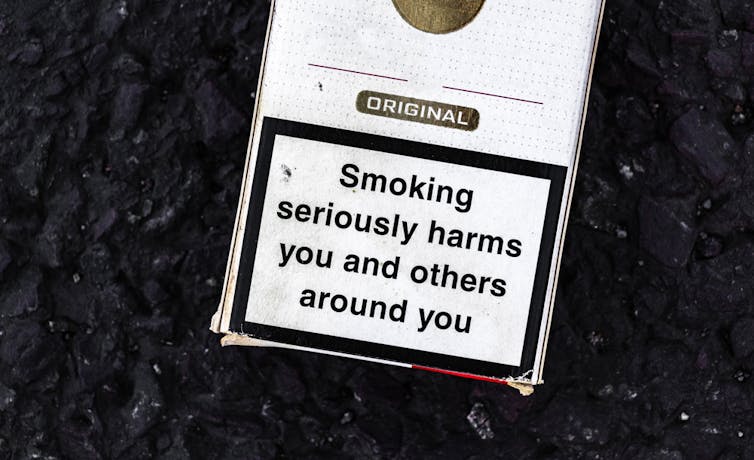
Vaping is a rapidly growing habit in Great Britain, particularly among younger people. Research by the anti-smoking charity Action on Smoking and Health found that in 2022 7% of 11- to 17-year-olds in Great Britain used e-cigarettes, up from 3.3% the year before.
Plain packaging needs to be brought in to protect young people’s health. This would undermine efforts to hook a new generation on nicotine. Without logos, colours or images to draw on, vape products will be less able to communicate with potential customers.
Vapes are aggressively marketed to young adults. Packaging draws on cultural references that teenagers like and understand, such as video games. And edgy brand names, such as Ninja Vapes, make the habit look rebellious.
Tobacco brands have long linked themselves with symbols and activities that appeal to certain consumer groups. The “Marlboro man” associated cigarettes with ideals of masculinity, for example. This attracted those intrigued by and wanting to emulate this form of masculinity. Today, vape brands are appealing to young people by linking them with things they value.
The packaging of vaping products makes them look fun: bright colours stand out, look cheerful and feel friendly. Sweet flavours are highlighted. Logos and slogans are bold and simple. You can even buy vapes packaged to look like disposable coffee cups. Others look like laughing gas canisters. Vape packaging also draws inspiration from punk and hipster themes. Logo designs recall such things as tattoos and graffiti. Names such as Bloody Mary reference alcohol. Meanwhile, those such as Geek Bar link with subcultures.
Because teenagers may have less knowledge of the consequences of their consumption, they can be more open to taking risks. Their inexperience also means teens may be more susceptible to misleading marketing information on the health effects of vaping.
Teen consumers are also susceptible to peer influence and will often use brands to fit in. Making vapes seem edgy and rebellious offers these as a way for young adults to fit in with like-minded others.
A new generation of consumers
A recent study by Cancer Research UK found that young people are far more likely than adults to notice e-cigarette marketing. And the marketing drive seems to be working. In Australia, around 20% of people aged 18 to 24 have used an e-cigarette or vaping device at least once. In the US in 2022, around 14% of high school students were found to use e-cigarettes. And in the UK, daily and occasional vape use is highest among the 16 to 24 age group, and increasing fast from 7% of this demographic in 2020 to 11% in 2021.
This is a problem because vaping has been found to be addictive and damaging to health. Researchers at Australian National University have found vapes are harmful and addictive. Their investigations linked vaping with a wide range of physical, mental and environmental health issues.
Let’s not make the same mistake again
It took 50 years to regulate traditional cigarette marketing. We should not let that happen with e-cigarettes. Plain packaging legislation would be an efficient way to reduce the recruitment of new customers. Politicians and regulators should get ahead of consumer trends and do this as soon as possible.

Research shows that plain packaging can increase awareness of the health risks of smoking. And data collected in the UK found health warnings on plain packs have more of an effect on smokers than those on branded packs.
Where plain packaging has been adopted, it has constrained a powerful sales tool long used by tobacco brands. Encouragingly, one study of young adult smokers in France found that plain packaging was linked with increased feelings of wanting to reduce or quit smoking. If we remove the packaging, we might not only stop more teenagers from taking up smoking but help those who already have to kick the habit.
Brendan Canavan does not work for, consult, own shares in or receive funding from any company or organisation that would benefit from this article, and has disclosed no relevant affiliations beyond their academic appointment.
This article was originally published on The Conversation. Read the original article.







